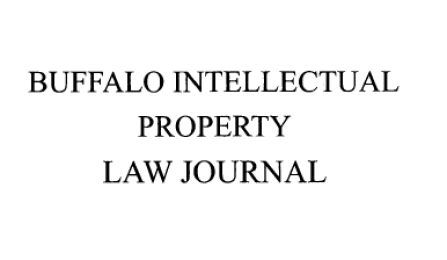LAW LINKS - FEBRUARY 2016
IP Journal takes on new patent appeals processes

The Buffalo Intellectual Property Law Journal looks at the emerging field of the post-grant review process established by the 2011 America Invents Act.
In 2016, the Buffalo Intellectual Property Law Journal broke new ground as it focused it's Volume 11 issue on a series of articles on the emerging field of the post-grant review process established by the 2011 America Invents Act.
Editor in chief John Fraczek '16 says the student editors chose the theme for two reasons. “Even though we’re a tech- and IP-focused journal, we hadn’t done a lot with patents,” he says. “But also, the prestige of a journal is based on who is using that journal and citing it in case opinions and different law review articles. We wanted to increase our prestige among the IP and the general legal community, and to do that you have to find the correct topic.”
Hence the focus – unique to the journal – on challenges that are sometimes made to patents granted by the U.S. Patent and Trademark Office, including through the newly created Patent Trial and Appeal Board. The idea grew out of connections that journal alumnus Conor Flynn ’15 made with practitioners working in this specialty, at an American Bar Association conference in Boston in 2014.
“Half of the America Invents Act, and what had received the most press coverage, was that the United States had converted to a first-to-file country,” says Flynn, who now works in the IP law department of Xerox Corp. in Webster, N.Y. “But the other half addressed how patents were handled once they were issued. It offered new mechanisms for people to challenge the validity of patents, and all these mechanisms created novel legal and business issues.”
Fraczek explains that there’s little opportunity for third parties to challenge the patentability of an idea during the PTO’s initial review process. But, he says, the new appeals board makes it possible for challengers – such as business competitors – to contest patents that have already been granted, and they may be able to do so cheaper and faster than by suing in federal court.
Most of the authors in the theme issue are IP attorneys who are putting the new mechanism into practice, rather than law professors. “We thought that practitioners would be people who see how it actually operates,” Fraczek says. “Since it’s so fresh and so new, whoever is doing it now has the most experience dealing with it.”
Among the featured articles are:
- Flynn’s overview of the work of the Patent Trial and Appeal Board, noting that the Patent and Trademark Office has considerable power in determining what ideas are patentable.
- A piece by Tom Irving and Stacy Lewis of the Washington, D.C., law firm Finnegan, Henderson, Farabow, Garrett & Dunner, on how inter partes reviews have hurt patent owners (and how denials of this review have offered some hope to patent holders).
- An article by Jonathan Stroud, who is employed by Unified Patents, Inc., and Linda Thayer and Jeffrey C. Totten, of the Finnegan firm, argues that the law pertaining to district court stays has changed in response to these new post-grant review processes.
In addition to its paper subscription base, the Buffalo Intellectual Property Law Journal is indexed on Westlaw and LexisNexis.